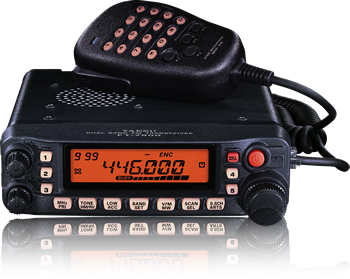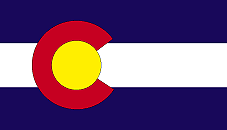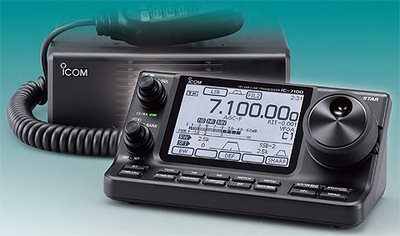Posts Tagged ‘VHF’
 How Much Does That Second Band Cost?
How Much Does That Second Band Cost?
 I encourage newly licensed radio amateurs to go ahead and get a dual-band FM rig…handheld, mobile or both. I think the additional cost of the dualbander with both 2 Meters (146 MHz) and 70 cm (440 MHz) is justified by having the ability to operate on the additional ham band. I have noticed that the price of the single-band 2 Meter mobiles are pretty low, less than $200… a real bargain in terms of technology. This made me wonder what the price premium for the second band (70 cm) really is.
I encourage newly licensed radio amateurs to go ahead and get a dual-band FM rig…handheld, mobile or both. I think the additional cost of the dualbander with both 2 Meters (146 MHz) and 70 cm (440 MHz) is justified by having the ability to operate on the additional ham band. I have noticed that the price of the single-band 2 Meter mobiles are pretty low, less than $200… a real bargain in terms of technology. This made me wonder what the price premium for the second band (70 cm) really is.
I pulled all of these prices from the same major ham radio web site, trying to keep some consistency among the price of the various models. (I ignored specials and coupon pricing.) I looked at a basic 2 Meter FM rig and any comparable dual band models from the same manufacturer. I tried to stick to the basic transceivers and not include models that had advanced features such as D-STAR and APRS in them.
The data is captured in the table below. Note that I differentiated between a single receiver (one frequency at a time) dual-band radio and a two receiver dual-band radio, since the latter variety is much more expensive. I calculated a percent premium for each of the dual-band transceivers, calculated as the percent increase in price over the single-band radio from the same manufacturer. I think this is the most objective way to describe the extra cost of a dual-band radio.
| Transceiver | Price | Bands | Percent Premium |
| Yaesu FT-2900R | $185 | 2M | |
| Yaesu FT-7900R | $330 | 2M/70cm | 78% |
| Yaesu FT-8800R | $460 | 2M/70cm Dual Receiver | 149% |
| ICOM IC-2300H | $260 | 2M | |
| ICOM IC-2820H | $670 | 2M/70cm Dual Receiver | 158% |
| Alinco DR-135T | $170 | 2M | |
| Alinco DR-635T | $320 | 2M/70cm Dual Receiver | 88% |
| Kenwood TM-281A | $145 | 2M | |
| Kenwood TM-V71A | $395 | 2M/70cm Dual Receiver | 172% |
It is worth noting that only Yaesu and Alinco offer a single-receiver dual-band rig. These two radios are 78% and 88% more expensive than their single band counterparts (less than twice the cost). The two-receiver dual-band radios are consistently more expensive, with a price premium ranging from 149% to 172%. While these rigs are often described as having two radios in one, they are more than twice as expensive as a single-band radio.
Although I appreciate the extra utility of the two-receiver radios, it looks to me like the best value is with the single-receiver dual-band rigs.
What do you think?
73, Bob K0NR
 Ham Radio Action Next Weekend – Sept 8/9
Ham Radio Action Next Weekend – Sept 8/9
 There are three excellent ham radio activities going on this coming weekend. Check these out and see if there is an activity that catches your interest. This is written for people in Colorado but items #1 and #3 are North American wide.
There are three excellent ham radio activities going on this coming weekend. Check these out and see if there is an activity that catches your interest. This is written for people in Colorado but items #1 and #3 are North American wide.
- ARRL September VHF QSO Party – noon MDT on Saturday until 9 PM MDT on Sunday http://www.arrl.org/september-vhf
- Colorado FM Sprint – a mini version of the September VHF QSO Party,
using FM only on these bands: 146 MHz, 222 MHz and 440 MHz
Saturday from noon to 7 PM MDT
http://www.qsl.net/k0yb/Colorado_FM_Sprint.html
Suggested frequencies: 146.58, 146.55, 223.5, 446.000, 446.100 MHz FM simplex - North American Summits On The Air (SOTA) Weekend
SOTA activations all over North America
http://na-sota.org/NASOTA_Weekend.html
Go here to see announced summit activations: http://www.sotawatch.org/
VHF contacts are usually on 146.52 MHz
(Note: this frequency is NOT allowed for contacts in the
Sept VHF QSO Party and Colorado FM Sprint)
HF contacts are on frequencies listed on sotawatch.org
Wow, lots of stuff to choose from!
At the very least, I’d suggest getting on the air Saturday afternoon to see if you can work some of the VHF contest stations. They are likely to be some mountaintop SOTA stations active at that time, too. Some of these folks may try to work the VHF contests AND do the SOTA thing on the same expedition.
73, Bob K0NR
 Lighter yagi’s
Lighter yagi’s
Over the summer I managed to ‘do’ 2 out of the 5 available 2m Backpacker contests. These to me are a great opportunity for me to get out on the fells and enjoy a longer spell on a summit with a nice qrp rig and some simple gear. The trouble with contesting is that inevitably you want to do better. So what’s the likely areas for improvement. Well there’s the rig, coax and antenna.
The rig is an ft817 and its not going anywhere fast. I sold once once then instantly regretted it. So it’s not going to be changed in a hurry. Yes it has its problems but frankly it just works and is relatively light so its a keeper.
Coax…Hmm work in progress. RG213 is too heavy, Ecoflex just isn’t flexy enough for summit packing. I’m yet to find the ‘perfect coax’. I’m leaning towards a trial with some Messi & Paoloni Ultraflex 7 as I like Mini 8 as a size but am looking for perfection here kids. This just means a reduction in losses to something as low as reasonably practicable as the saying goes
Antenna. Well I do like my now obsolete Sotabeams SB270 ( A 3 element yagi that lives inside its own plastic boom). Its light and doesn’t get thrown about too much in the wind and has lasted years. Trouble is it’s looking a bit knackered now and 3 elements is a bit short. I bought a 5 element LFA off innovantennas years ago and was really disappointed with the build quality. The elements just weren’t secure enough and it was way too heavy. Too heavy for a UKAC /p so no good for a summit. But it is well designed and the elements are quite light.
So the plan is to change the coax. I’ll do that over the winter. In the mean time I’ve taken a few grams off the yagi.
The boom was very substantial 32mm2 2mm thick Aluminium (note spelling you stupid browser ;-)). The boom weighs in at 1150g as is.Swapping this for 20mm2 1mm thick boom I’m down to 560g. Roughly half the weight. Element clamps have been swapped for the G1YBB method of IML mouldings plates and cheapo pipe clamps

You can see the immediate difference in size. The original beam is clearly made for sticking up at home then forgetting about it, ignoring the defects with this particular one.
Now with the elements added. They simply snap in to the pipe clamps and are held in place without any bother.

We’ll see how easy it is to carry up the Old Man of Coniston next year but at 1240g it is nearly 500g lighter than the original with the same RF performance.
I bought 2 pieces of aluminium and have a larger 2m and 70cm DK7ZB yagi that needs the same treatment (I went the other way this time, it was too light and flimsy) that I’ll give a run out during the Christmas Cumulative content
 A Great SOTA Weekend
A Great SOTA Weekend
 For the long Labor Day weekend, Joyce (K0JJW) and I headed to the cabin in the mountains. My main objective was to work the Colorado QSO Party. See previous post.
For the long Labor Day weekend, Joyce (K0JJW) and I headed to the cabin in the mountains. My main objective was to work the Colorado QSO Party. See previous post.
When in the mountains, I try to remember to monitor 146.52 MHz. You never know who might show up on that frequency…some of the locals chatting, a mobile station passing through, people camping or…a SOTA (Summits On The Air) station.
Sure enough, on Saturday, I heard Eric (W0ECE) calling from the summit of Mount Evans on 146.52 MHz. Joyce and I gave him a SOTA contact (and I got a new county for the CO QSO Party). Then, on Sunday morning, we heard Dave (KI6YMZ) calling from the summit of Mount Shavano, also on 146.52 MHz. We were mobile at the time and both of us worked Dave to give him two contacts. Then on Monday morning, again listening to 146.52 MHz, we heard Bob (AD6QF) on Quandary Peak. We handed out two more contacts.
Sometime on Monday morning, we started thinking of doing a hike. That led to the idea of hiking up Kaufman Ridge North (W0/SP-085), a SOTA peak about 2 miles from our cabin. It had not been activated before, so that seemed like a good idea.
Except for the fact that I did not bring along any of my SOTA gear. (Note to self: whenever you are in the mountains, take along the SOTA gear.) I scrounged around the cabin and found a dualband HT with fully charged battery. Unfortunately, the only antenna was the rubber duck. (The World’s Most Convenient Crummy Antenna.)
Oh, what the heck, we gave it a try anyway. It was an easy climb to the summit. I got out the HT and called on 146.52 MHz. I quickly got a reply from Ben (KD0ELP) and Mark (KE0P). A little more calling and I raised Jerry (N0VXE) in Salida, CO. To get the minimum four contacts, I tried calling on two of the local repeaters and found Dave (K0HTX) who QSY’d to 446.00 MHz for a simplex contact with me. That made it an official SOTA activation, so we headed down the mountain.
A good weekend for SOTA activity. Keep listening on 146.52 MHz.
73, Bob K0NR
 K0NR Colorado QSO Party Results
K0NR Colorado QSO Party Results
 It was a fun day working the Colorado QSO Party from the cabin near Trout Creek Pass. State QSO parties are contests designed to focus attention on a particular state, with an emphasis on activation of counties. This brings out the County Hunters and other folks interested in working that particular state.
It was a fun day working the Colorado QSO Party from the cabin near Trout Creek Pass. State QSO parties are contests designed to focus attention on a particular state, with an emphasis on activation of counties. This brings out the County Hunters and other folks interested in working that particular state.I decided to operate from our cabin near Trout Creek Pass in Park County, which is considered “rare” by most folks. My station was a Yaesu FT-950 running 100W to a trap dipole up in the trees. I mostly operated phone since I don’t consider my CW skills up to that challenge of a contest. I did make a few CW contacts at the request of a few folks than wanted Park County on CW.
Thanks to all of the mobile stations out there, both in Colorado and out of state. I was surprised how many people were mobile or operating portable (often camping out for the holiday weekend). I normally monitor 146.52 MHz while up at the cabin for anyone out hiking or mobile. I heard Eric W0ECE doing a SOTA activation on Mt Evans and worked him for QSO Party points and SOTA points.
The score below includes the CW contacts so the score will drop a bit when I submit in the phone only category (77526, I think).
I was disappointed with the Qs on 15 Meters but I looked in my log from last year and it was also light on 15 Meter contacts. Twenty meters is always a bit crowded and I really like when 15M and 10M open up. I almost doubled my score from last year, so I was happy with the result.
Band Mode QSOs Pts Sec Mul 7 CW 3 12 2 0 7 LSB 93 186 23 1 14 CW 1 4 1 0 14 USB 400 802 41 0 21 USB 23 64 5 0 28 USB 1 2 0 0 144 FM 4 8 3 0 Total Both 525 1078 75 1 Score : 81,928
Thanks to the Pikes Peak Radio Amateur Association for sponsoring this event.
73, Bob K0NR
 New Transceiver from ICOM: IC-7100
New Transceiver from ICOM: IC-7100
ICOM has shown the new IC-7100 at the JARL show in Tokyo. The interwebz is buzzing with information, including a preliminary data sheet.
My scan of the preliminary datasheet indicates that this radio is in the class of the IC-7000 or even the IC-706. It covers all modes on HF plus 6 Meters, 2 Meters and 70 cm. (It also has the 70 MHz band which is a nice add for the European countries that have that band.) The radio includes DV (D-STAR) modulation capability and has a new touchscreen user interface. The slanted control panel is meant to make the touchscreen more accessible.
A new HF plus VHF/UHF radio always gets my attention (see my plea for an FT-950 with 2 Meters). I am starting to think that the real benefit of this rig is the addition of D-STAR capability, which would a good but not essential feature to have.
What do you think?
73, Bob K0NR
Update (30 Aug 2012): Universal Radio has the radio on its website.
There’s a good video look at the radio here.
 Pikes Peak to Mt Sneffels – 160 Miles
Pikes Peak to Mt Sneffels – 160 Miles
Here’s a video of my contact from Mt. Sneffels with Stu W0STU on Pikes Peak during the Colorado 14er Event. The QSO was made on 2M FM with 5W of transmit power on both ends.













